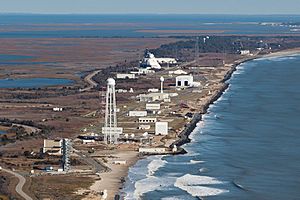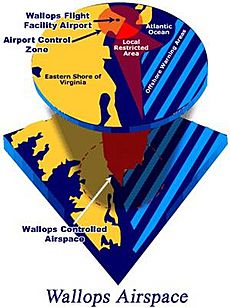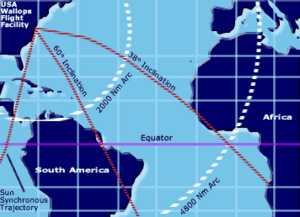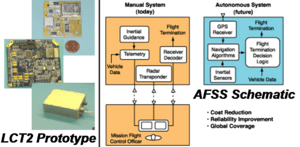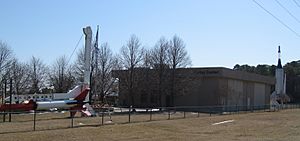Wallops Flight Facility facts for kids
 |
|
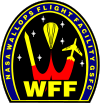
Wallops Flight Facility insignia
|
|
| Agency overview | |
|---|---|
| Formed | 1945 |
| Preceding agencies |
|
| Headquarters | Wallops Island, Virginia, 37°56′00″N 75°28′04″W / 37.93333°N 75.46778°W |
| Employees | 1,400 |
| Agency executive |
|
| Parent agency | Goddard Space Flight Center NASA |
| Map | |
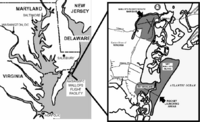
Wallops Flight Facility with its three separate parcels of property
|
|
The Wallops Flight Facility (WFF) (IATA: WAL, ICAO: KWAL, FAA LID: WAL) is a special place where NASA launches rockets and balloons. It's located on Wallops Island in Virginia, about 100 miles (160 km) north of Norfolk. This facility is run by the Goddard Space Flight Center and helps NASA and other government groups with their science missions.
Wallops is a busy place! It has special equipment to launch many types of sounding rockets. These are small rockets that fly high into the atmosphere but don't go into orbit. They also launch larger rockets that can reach orbit. Scientists also use Wallops to send high-altitude balloons into the sky. These balloons carry scientific tools to study Earth's atmosphere and outer space. Wallops also has an airport for testing research aircraft, including unmanned aerial vehicles (drones).
Since it started in 1945, over 16,000 rockets have launched from Wallops. These launches help us learn about how airplanes, rockets, and spacecraft fly. They also help us understand Earth's upper atmosphere and the space around our planet. The rockets range from small weather rockets called Super Loki to big rockets that can put things into orbit.
Wallops Flight Facility also helps the National Oceanic and Atmospheric Administration (NOAA) with their science missions. Sometimes, it even helps other countries and private companies. The facility also supports the United States Navy by helping them test aircraft and ship systems. Wallops has special mobile equipment like radar and telemetry receivers. These can be flown to different places around the world. This allows scientists to launch rockets from remote areas and collect important data. Wallops' mobile equipment has been used in places like the Arctic, Antarctic, South America, Africa, Europe, Australia, and even at sea. About 1,400 people work at Wallops, including NASA employees, contractors, Navy personnel, and NOAA staff.
Contents
History of Wallops Flight Facility
Early Days and NACA
In 1945, before NASA existed, an agency called the National Advisory Committee for Aeronautics (NACA) started a rocket launch site on Wallops Island. It was called the Pilotless Aircraft Research Station. Here, scientists studied how things fly at very high speeds. They used rockets to gather information that they couldn't get from wind tunnels or labs.
Becoming Part of NASA
In 1958, the U.S. Congress created NASA. NACA's research centers, including the one at Wallops, became part of NASA. The Pilotless Aircraft Research Station then became its own facility, called Wallops Station. It reported directly to NASA Headquarters.
In 1959, NASA took over the former Naval Air Station Chincoteague. The engineering and office work for Wallops moved to this new location. The name changed again in 1974 to Wallops Flight Center. Finally, in 1981, it became known as Wallops Flight Facility when it joined the Goddard Space Flight Center.
Important Space Tests
In its early years, Wallops focused on studying how things fly at high speeds. Between 1959 and 1961, Wallops played a key role in NASA's first human spaceflight program, the Mercury program. They tested parts of the Project Mercury capsules here before astronauts launched from Cape Canaveral Air Force Station in Florida. These tests used a small rocket called Little Joe. They checked if the spacecraft's escape system and life support systems worked correctly. Two monkeys, Sam and Miss Sam, even flew on these tests as pioneers for astronauts. Both were recovered safely.
The first time something was launched into orbit from Wallops Island was on February 15, 1961. It was a satellite called Explorer IX, carried by a Scout rocket.
More recently, on September 6, 2013, the Lunar Atmosphere and Dust Environment Explorer (LADEE) was launched from Wallops. It rode on a Minotaur V rocket. This was the first time an American mission to the Moon had launched from anywhere other than Florida.
Protecting the Island
Wallops Island faces a challenge with beach erosion. The ocean is slowly washing away the land, about 10 to 22 feet (3 to 7 meters) each year. This is partly due to rising sea levels. NASA has to keep adding sand to the shoreline to protect the facility.
Wallops Flight Facility also has a permanent control station for NASA's RQ-4 Global Hawk drone.
Wallops Facilities
The main part of Wallops Flight Facility is on the Delmarva Peninsula in Virginia. It's about 5 miles (8 km) west of Chincoteague, Virginia. The entire facility covers about 6,200 acres (25 square kilometers). It's made up of three separate areas: the Main Base, the Mainland, and the Wallops Island Launch Site. The Mainland and the Wallops Island Launch Site are about 7 miles (11 km) southeast of the Main Base.
Airspace Control
Wallops has its own controlled airspace, managed by Federal Aviation Administration (FAA) certified air traffic controllers. This includes:
- The WFF Airport Control Zone, which extends up to 2,500 feet (760 m) high within a 5-mile (8 km) radius of the airport.
- A restricted area called R-6604, which connects Wallops' airspace to warning areas offshore.
Buildings and Launch Pads
Wallops has FAA-certified runways for aircraft and a special runway for testing unmanned aerial vehicles (UAVs). It also has emergency services for crashes and fires. The facility has buildings to receive, check, assemble, and store rocket motors and other explosive devices.
The Wallops Island Launch Site has six launch pads. These are the platforms where rockets take off. There are also three blockhouses, which are strong buildings where people control the launches safely. Other buildings are used to prepare and assemble rockets before they launch.
Tracking and Communication
The Wallops Research Range includes systems on the ground and mobile systems, plus a control center. Its radar facilities track and watch rockets during flight. Telemetry facilities use antennas and receivers to collect data from rockets. They also have systems to send commands to rockets and optically track them with cameras. Wallops provides high-quality digital photos and videos. These are used for safety, surveillance, and to analyze what happened after a launch. They also help document projects and environmental studies. Wallops has many communication systems for voice, video, and data to support launches and tests.
Research Airport
The WFF Research Airport is on the Main Base. It has three runways, ranging from 4,810 feet (1,466 m) to 8,750 feet (2,667 m) long. There are also taxiways and ramps for aircraft. One runway has a special test section with different surfaces for runway research.
Weather is very important for all operations at Wallops, including rocket and balloon launches. Wallops has its own weather services that measure conditions in the upper atmosphere. The S-band Doppler radar system at Wallops, called SPANDAR, can track targets up to 60,000 kilometers away. It's so sensitive it can detect a single raindrop or small changes in air caused by sea breezes.
Mobile Systems for Global Launches
Wallops has mobile equipment for tracking rockets, including telemetry, radar, and command systems. This equipment can be moved to different places to help with launches where there isn't already a tracking station. This allows Wallops to support rocket launches from remote locations around the world. While Wallops Island is the main launch site, major rocket campaigns have been supported in places like Poker Flat, Alaska; Andoya, Norway; and Kwajalein Island in the Marshall Islands. This mobile equipment can also work with NASA and Department of Defense networks.
Developing New Technologies
Since 2001, engineers at NASA Wallops Flight Facility have been working on new technologies to make launches and flight tests better and more affordable.
Two main projects they are working on are the Autonomous Flight Safety System (AFSS) and the Low Cost TDRSS Transceiver (LCT2).
- Autonomous Flight Safety System (AFSS): This project is developing a system that can be put on a rocket itself. It would watch the rocket's path and, if needed, safely end the flight without needing commands from the ground.
- Low Cost TDRSS Transceiver (LCT2): This project aims to create a cheaper device that allows rockets to communicate through NASA's Tracking and Data Relay Satellite System (TDRSS). This is useful when a rocket flies so far away that it can no longer be seen from the launch site.
Wallops Missions
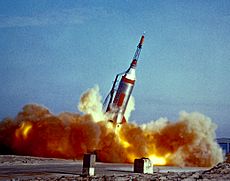
Wallops Flight Facility has several main mission areas:
- Sounding Rockets: Launching small rockets for scientific research.
- Scientific Balloons: Sending large balloons high into the atmosphere with scientific instruments.
- Aircraft: Testing new aircraft and drone technologies.
- Range and Mission Management: Managing the launch range and supporting missions.
- Small Launch Vehicle Research: Developing and testing smaller rockets.
- Mission Planning Lab: Helping plan and prepare for missions.
Wallops supports almost all of NASA's main goals, including:
- Science: Studying Earth, the solar system, the universe, and the Sun.
- Exploration: Working on future human spaceflight and exploration systems.
- Aeronautics: Developing new aviation technologies.
- Space Operations: Supporting the International Space Station and other space missions.
Facility Directors
Here are the people who have led the Wallops Flight Facility:
Commercial Spaceport
In 1998, the Virginia Commercial Spaceflight Authority, which later joined with Maryland, built the Mid-Atlantic Regional Spaceport at Wallops. They leased land from NASA for this. In December 2006, the first rocket launched from this commercial spaceport.
Visitor Center and Education
The Wallops Visitor Center is a great place to visit! It has many hands-on exhibits where you can learn about NASA's technologies. They also host weekly educational activities and programs for children.
Once a month, NASA invites model rocketry fans to launch their own rockets from the Wallops launch site. NASA staff also launch models of real rockets and explain the spacecraft they carry. You can find the schedule for sounding rocket launches on the official Wallops website.
Educational Programs
For many years, Wallops hosted the NSIP Sub-SEM and SEM projects. NSIP stood for the NASA Student Involvement Project. The Sub-SEM project allowed students to design experiments for a rocket that would fly very high. The SEM project let students design experiments that would fly on a future Space Shuttle mission. These projects gave students and teachers a chance to spend a week at Wallops, doing experiments and learning about the facility. However, these programs were eventually stopped due to budget changes.
Incidents at Wallops
Over the years, there have been a few incidents during tests or launches at Wallops.
- On April 2, 1957, a Lockheed P-2 Neptune plane exploded after takeoff, and all eleven people on board died.
- On October 23, 1995, a Conestoga 1620 rocket failed 46 seconds after liftoff and broke apart. The company stopped making these rockets after this.
- On October 27, 1998, a Learjet 45 plane was damaged during a water test on the runway. The pilot lost control, and the plane hit a truck. Only minor injuries were reported.
- On August 22, 2008, an ALV X-1 sounding rocket was intentionally destroyed 20 seconds after launch because it went off course.
- On October 28, 2014, an Antares rocket carrying supplies for the space station failed shortly after launch. Both the rocket and its cargo were destroyed at the nearby Mid-Atlantic Regional Spaceport.
Partnerships
The NASA Wallops Flight Facility works with many important organizations. Some of these include:
- Mid-Atlantic Regional Spaceport (MARS)
- U.S. Navy Surface Combat Systems Center (SCSC)
- Navy Test and Training Ranges
- U.S. Space Force Space Launch Delta 45, Eastern Range
- U.S. Coast Guard
- National Oceanic and Atmospheric Administration (NOAA)
- Marine Science Consortium (MSC)
- White Sands Missile Range (WSMR)
Wallops also worked with the National Security Agency during the Cold War on experiments involving ionized clouds for communication.
Images for kids
See also
- List of space companies and facilities in Virginia


